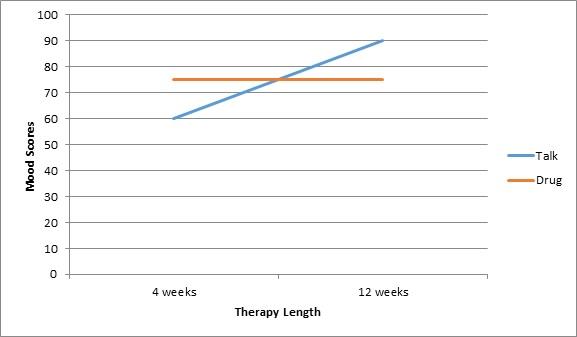The Process of Research in Psychology
Answers to Test Yourself
(1) a. (2) b. (3) a. (4) b. (5) No main effect of therapy type (each column has a mean of 75), main effect of therapy length (row means of 67.5 for 4 weeks vs. 82.5 for 12 weeks--longer has higher score), and interaction effect such that drug therapy has higher score for 4-week length, but talk therapy has higher score for 12-week length. (6) See the following sample graph.

(7a) One independent variable is the “treatment” for separation anxiety with levels of chew toy and worn clothing. The other independent variable is length of outing with levels short and long. (7b) Both were within-subjects. (7c) Yes, the effectiveness of the treatment depended on the length of outing such that the chew toy was best for short outings and the worn clothing was best for long outings. (8a) Independent variable 1 = type of event; levels = false, true; Independent variable 2 = type of false event; levels = criminal, non-criminal; dependent variables = ratings of anxiety, vividness, and confidence; also percentage of subjects who had false memory for event. (8b) Independent variable 1 = type of trial; levels = near, far; quasi-independent variable 2 = age group; levels = adult, child; dependent variable = brain activity during the sessions. (8c) Independent variable 1 = concept; levels = fat, thin; independent variable 2 = concept pairing; levels = match (e.g., fat-negative), mismatch (e.g., fat-positive); dependent variable = reaction time for key press. (8d) Independent variable = object locations; levels = organized by category, random organization; subject variable = age group with levels = 7-, 9-, and 11-year-olds and adults; dependent variable = location errors (difference between location object is placed in during the test phase and the object’s original location in the study phase). (9a) The independent variables are smile group: smile or no smile--it is manipulated between-subjects because the subjects only complete the experiment in one of the two groups and gender of thanking researcher--male or female--also between-subjects. (9b) Yes, the effect of smile depended on the gender of the researcher such that smiles had an effect when the researcher was female, but not when the researcher was male.
